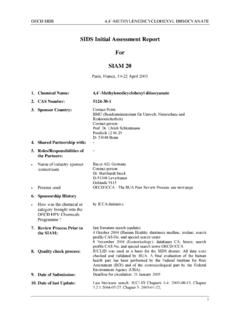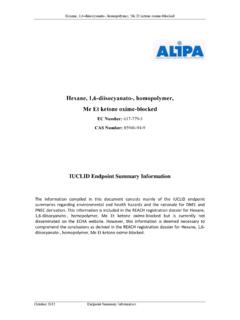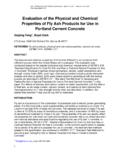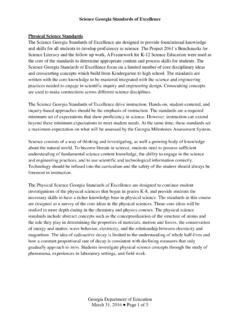Transcription of Properties, Hazards and Safety Information for …
1 February 2013 Product: H12 MDI (4,4 -Methylene dicyclohexyl diisocyanate; CAS No. 5124-30-1) Physical and chemical data Physical state liquid Colour colourless to light yellow Odour slight inherent odour, lachrymatory Melting point/range approx. 20 C Boiling point/range Decomposition above 300 C at normal pressure Flash point 200 C Self-Ignition temperature 225 C at 1013 hPa Vapour pressure hPa at 20 C Density (25 C) Water solubility reacts with water Viscosity approx. mPa*s at 55 C Hazardous decomposition products no dangerous decomposition products if properly stored and handled Hazardous reactions with amines, acids, bases, strong oxidants, alcohols.
2 Decomposes in water with formation of CO2 (leading to an increase in pressure in closed containers!) *More detailed Information should be taken from the suppliers Material Safety Data Sheets properties , Hazards and Safety Information for H12 MDI* Toxicological Information Short term exposure Ingestion Acute oral toxicity is low: LD50 (rat) = 18,200 mg/kg Ingestion may irritate the gastro-intestinal tract. Skin contact Acute dermal toxicity is low: LD50 (rat) > 7,000 mg/kg H12 MDI is a skin irritant and a skin sensitizer.
3 Eye contact Animal studies have shown that H12 MDI is irritating to the eye. Inhalation H12 MDI is toxic by inhalation of aerosols (LC50, rat = mg/l/4h). Vapour and aerosols are irritating to the respiratory tract. In sensitized people very low concentrations may lead to asthmatic symptoms, the onset of which may be delayed for several hours. Repeated exposure / longterm effects Skin contact May cause sensitization by skin contact. Inhalation May cause sensitization by inhalation. Chronic exposure by inhalation may result in permanent decrease in lung function.
4 In a 28-day-inhalation study with rats primarily the upper respiratory tract was the target of H12 MDI. With regard to histopathological changes, all lesions observed were related to portal-of-entry, local irritant effects (nasal passages, pharynx, and larynx). Genotoxicity H12 MDI did not induce genotoxic effects in several studies with bacteria and mammalian cell culture Carcinogenicity No animal studies have been performed yet. Reproductive toxicity In inhalation studies H12 MDI did not reveal signs of developmental toxicity nor adverse effects on the reproduction of rats in the absence of parental toxicity.
5 Exposure controls/Personal protection equipment General Workers with a hypersensitivity of the respiratory tract and/or the skin ( asthmatics or those suffering from chronic bronchitis or chronic skin complaint) should not be exposed to this chemical. OELs In many countries occupational exposure limits for H12 MDI have been set up. These can be found under OELs H12 MDI (see website under Links Regulatory Information ) DNEL Application Area Workers Workers Route of Exposure Inhalation Inhalation Health Effect Acute - local effects Long-term - local effects mg/m3 mg/m3 mg/m3 PNEC PNEC freshwater PNEC marine water PNEC intermittent release PNEC sediment PNEC soil PNEC STP > mg/l > mg/l > mg/l > mg/kg dw > mg/kg dw mg/l Respiratory protection Respiratory protection is required if an inhalative exposure can not be excluded.
6 Depending on the exposure scenario relevant for the interesting application more details are given in the extended MSDS of the supplier. Hand protection Chemical resistant protective gloves should be worn, - butyl rubber with a thickness mm (breakthrough time 480 min) - fluorinated rubber with a thickness mm (breakthrough time 480 min) - nitrile rubber with a thickness mm (breakthrough time 480 min) Contaminated gloves should be disposed of. Body protection Body protection should be chosen based on activity and possible exposure, apron, protecting boots, chemical-protection suit.
7 Eye protection Face protection/close-fitting protective goggles should be worn. First aid measures General Contaminated clothing must be taken off immediately. Skin contact Remove any contaminated clothing immediately. Wipe of mechanically and wash affected areas thoroughly with soap and water or with a cleanser based on polyethylene glycol for at least 15 minutes. Dispose of contaminated clothing or wash thoroughly before reuse . For severe exposures, the affected person should get under a Safety shower, using the flushing action of the water to remove the bulk of the chemical, then remove contaminated clothing and wash skin with soap and water.
8 Seek medical attention. For lesser exposures, the individual should seek medical attention if irritation develops or persists after the area is washed. Inhalation The person should move to an area free from risk of further exposure. Oxygen or artificial respiration should be administered as needed. Asthmatic-type symptoms may develop and may be immediate or delayed up to several hours. Treatment is essentially symptomatic. A physician should be consulted. Eye contact Flush with large amounts of lukewarm water for at least 15 minutes, holding eyelids open all the time.
9 Refer the affected individual to an eye specialist or other physician for immediate follow-up. Ingestion Vomiting should not be induced and nothing should be given orally to an unconscious or convulsing person. A physician should be consulted. Ecological Information Biodegradability H12 MDI is not readily biodegradable. It reacts with water forming solid insoluble polyurea, methylenedicyclohexyl diamine (H12 MDA) and CO2, thus the predominant removal mechanism is expected to be hydrolysis. Polyurea is more or less inert and due to its molecular size not bioavailable.
10 H12 MDA is not readily biodegradable. Bioaccumulation Due to hydrolysis in water bioaccumulation of H12 MDI is not expected. Bioaccumulation of the hydrolysis product H12 MDA is also not expected due to its high solubility in water and low logKow. Acute toxicity to aquatic organisms H12 MDI offers a low level of aquatic toxicity. It is not toxic to aquatic organisms up to its limit of solubility in water: - LC0 (fish, Brachydanio rerio, 96h) > - EC50 (bacteria) = 191mg/l - EC0 (Daphnia magna, 48h) > - EC50 (algae, Scenedesmus subspicatus, 72h) > EC Classification and labeling A) According CLP regulation 1272/2008 1.










